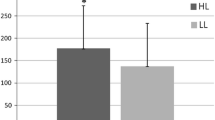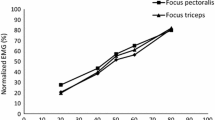Abstract
Purpose
This study aimed at investigating enjoyment, affective states (affective valence and perceived activation), and perceived exertion during acute resistance exercise with machines or free weights.
Methods
Thirty recreationally strength-trained males performed two training sessions on 2 separate days using a descending pyramid training system, one performed with three machines (chest press, shoulder press machine and leg press) and the other with three free weight exercises (bench press, front military press and squat). The Physical Activity Enjoyment Scale, the Borg Scale for Rating of Perceived Exertion, the Feeling Scale, and the Felt Arousal Scale were administered at the end of each session.
Results
Analyses revealed higher scores on all the variables when participants exercised with free weights (p < 0.001). Enjoyment was positively related to perceived exertion only in the free weight session (r = 0.45; p < 0.01). When looking at the circumplex model of affect, results showed that resistance exercise performed with free weights resulted in a pleasant activation feeling for all participants, while the machine training condition determined high-activation pleasant state for the majority but also cases of low-activation, displeasure state.
Conclusions
Resistance training with free weights resulted in increased pleasantness and activation compared with machine training. The establishment of resistance training programmes should consider, close to physiological and technical aspects, also the affective response to different modalities of exercise, particularly when the aim is improving the general fitness.

Similar content being viewed by others
Abbreviations
- RT:
-
Resistance training
- RE:
-
Resistance exercise
References
Kwan BM, Bryan AD (2010) Affective response to exercise as a component of exercise motivation: attitudes, norms, self-efficacy, and temporal stability of intentions. Psychol Sport Exerc 11(1):71–79
Allender S, Cowburn G, Foster C (2006) Understanding participation in sport and physical activity among children and adults: a review of qualitative studies. Health Educ Res 21:826–835
Hagberg LA, Lindahl B, Nyberg L, Hellénius ML (2009) Importance of enjoyment when promoting physical exercise. Scand J Med Sci Sports 19:740–747
Garber CE, Blissmer B, Deschenes MR et al (2011) American College of Sports Medicine position stand. Quantity and quality of exercise for developing and maintaining cardiorespiratory, musculoskeletal, and neuromotor fitness in apparently healthy adults: guidance for prescribing exercise. Med Sci Sports Exerc 43:1334–1359
Thompson WR (2011) Worldwide survey of fitness trends for 2012. ACSMs Health Fit J 15(6):9–18
Ekkekakis P, Parfitt G, Petruzzello SJ (2011) The pleasure and displeasure people feel when they exercise at different intensities: decennial update and progress towards a tripartite rationale for exercise intensity prescription. Sports Med 41:641–671
Doyne EJ, Ossip-Klein DJ, Bowman ED, Osborn KM, McDougall-Wilson IB, Neimeyer RA (1987) Running versus weight lifting in the treatment of depression. J Consult Clin Psychol 55:748
Bartholomew JB, Linder DE (1998) State anxiety following resistance exercise: the role of gender and exercise intensity. J Behav Med 21:205–219
Focht BC, Koltyn KF (1999) Influence of resistance exercise of different intensities on state anxiety and blood pressure. Med Sci Sports Exerc 31(3):456–463
O’Connor PJ, Bryant CX, Veltri JP, Gebhardt SM (1993) State anxiety and ambulatory blood pressure following resistance exercise in females. Med Sci Sports Exerc 25:516–521
Bartholomew JB, Moore J, Todd J, Todd T, Elrod CC (2001) Psychological states following resistance exercise of different workloads. J Appl Sport Psychol 13:399–410
Arent SM, Landers DM, Matt KS, Etnier JL (2005) Dose–response and mechanistic issues in the resistance training and affect relationship. J Sport Exerc Psychol 27:92–110
Bibeau WS, Moore JB, Mitchell NG, Vargas-Tonsing T, Bartholomew J (2010) Effects of acute resistance training of different intensities and rest periods on anxiety and affect. J Strength Cond Res 24:2184–2191
SantaBarbara NJ, Whitworth JW, Ciccolo JT (2017) A systematic review of the effects of resistance training on body image. J Strength Cond Res 31(10):2880–2888
Chang YK, Etnier JL (2009) Exploring the dose–response relationship between resistance exercise intensity and cognitive function. J Sport Exerc Psychol 31:640–656
Bartholomew JB (1999) The effect of resistance exercise on manipulated preexercise mood states for male exercisers. J Sport Exerc Psychol 21:39–51
Belezza PA, Hall EE, Miller PC, Bixby WR (2009) The influence of exercise order on blood lactate, perceptual, and affective responses. J Strength Cond Res 23(1):203–208
Focht BC, Garver MJ, Cotter JA, Devor ST, Lucas AR, Fairman CM (2015) Affective responses to acute resistance exercise performed at self-selected and imposed loads in trained women. J Strength Cond Res 29(11):3067–3074
Russel JA (1980) A circumplex model of affect. J Pers Soc Psychol 39:1161–1168
Buscombe RM, Inskip H (2013) Affective change as a function of exercise intensity in a group aerobics class. J Exerc Sci Fit 11:42–49
Hall E, Chmelo E, DeWitt R, Kostura C, Morrison J, Miller P (2005) Do you feel the pump? Examination of affective responses to different modes of resistance training in college females. In: Morris T (ed) Proceedings of the 11th World Congress of Sport Psychology. International Society of Sport Psychology, Sydney
Miller PC, Hall EE, Chmelo EA, Morrison JM, DeWitt RE, Kostura CM (2009) The influence of muscle action on heart rate, RPE, and affective responses after upper-body resistance exercise. J Strength Cond Res 23(2):366–372
Hall EE, Ekkekakis P, Petruzzello SJ (2002) The affective beneficence of vigorous exercise revisited. Br J Health Psychol 7(1):47–66
Motl RW, Dishman RK, Saunders R, Dowda M, Felton G, Pate RR (2001) Measuring enjoyment of physical activity in adolescent girls. Am J Prev Med 21(2):110–117
Carraro A, Young MC, Robazza C (2008) A contribution to the validation of the physical activity enjoyment scale in an Italian sample. Soc Behav Pers 36:911–918
Carraro A, Gobbi E, Ferri I, Benvenuti P, Zanuso S (2014) Enjoyment perception during exercise with aerobic machines. Percept Mot Skills 119(1):146–155
Borg G (1998) Borg’s Perceived Exertion and Pain Scales. Human Kinetics, Champaign
American College of Sport Medicine (2010) ACSM’s guidelines for exercise testing and prescription, 8th edn. Lippincott Williams and Wilkins, Philadelphia
Hardy CJ, Rejeski WJ (1989) Not what, but how one feels: the measurement of affect during exercise. J Sport Exerc Psychol 11:304–317
Ekkekakis P (2009) Let them roam free? Sports Med 39:857–888
Svebak S, Murgatroyd S (1985) Metamotivational dominance: a multimethod validation of reversal theory constructs. J Pers Soc Psychol 48(1):107
Hunter GR, Seelhorst D, Snyder S (2003) Comparison of metabolic and heart rate responses to super slow vs. traditional resistance training. J Strength Cond Res 17(1):76–81
Paoli A, Moro T, Marcolin G, Neri M, Bianco A, Palma A, Grimaldi K (2012) High-Intensity Interval Resistance Training (HIRT) influences resting energy expenditure and respiratory ratio in non-dieting individuals. J Transl Med 10(1):237–245
American College of Sports Medicine (2009) American College of Sports Medicine position stand. Progression models in resistance training for healthy adults. Med Sci Sports Exerc 41(3):687–708
Greene DR, Petruzzello SJ (2015) More isn’t necessarily better: examining the intensity-affect-enjoyment relationship in the context of resistance exercise. Sport Exerc Perform Psychol 4(2):75–87
Ekkekakis P, Hall EE, Petruzzello SJ (2004) Practical markers of the transition from aerobic to anaerobic metabolism during exercise: rationale and a case for affect-based exercise prescription. Prev Med 38(2):149–159
Ekkekakis P, Hall EE, Petruzzello SJ (2008) The relationship between exercise intensity and affective responses demystified: to crack the 40-year-old nut, replace the 40-year-old nutcracker. Ann Behav Med 35:136–149
Author information
Authors and Affiliations
Corresponding author
Ethics declarations
Conflict of interest
The authors declare that they have no conflict of interest relating to the publication of this manuscript.
Ethical statement
All procedures performed in studies involving human participants were in accordance with the ethical standards of the University of Padua research committee and with the 1964 Helsinki declaration and its later amendments or comparable ethical standards.
Informed consent
Written informed consent was obtained from all individual participants included in the study.
Rights and permissions
About this article
Cite this article
Carraro, A., Paoli, A. & Gobbi, E. Affective response to acute resistance exercise: a comparison among machines and free weights. Sport Sci Health 14, 283–288 (2018). https://doi.org/10.1007/s11332-018-0427-4
Received:
Accepted:
Published:
Issue Date:
DOI: https://doi.org/10.1007/s11332-018-0427-4




